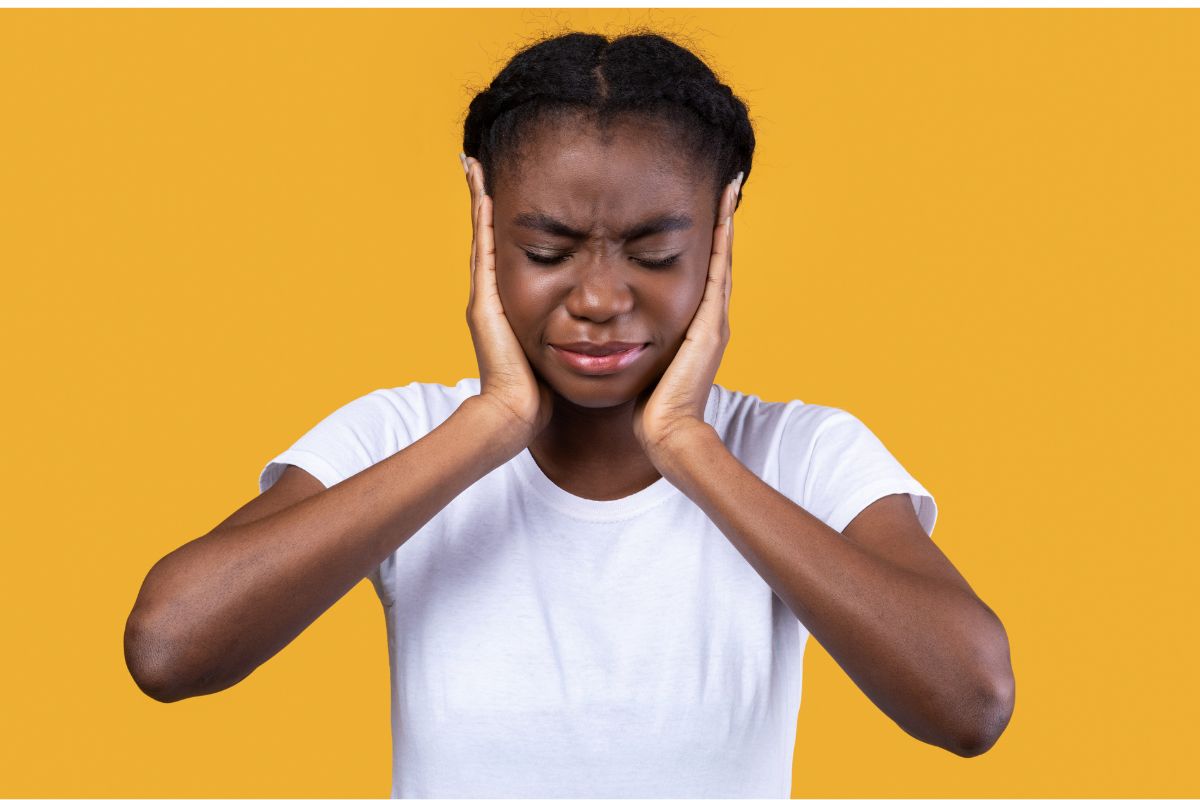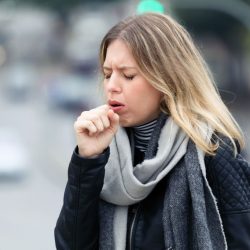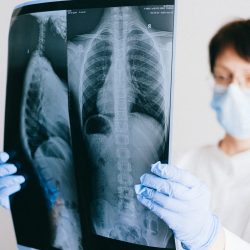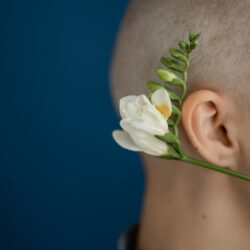Acute otitis” is an inflammatory and/or infectiousprocess involving the external ear and/or middle ear, triggered by a microbial agent with a most often nasopharyngeal portal of entry, which may either develop in isolation, or add to an acute nasopharyngeal pathology or a general infectious disease, or inaugurate an infectious syndrome.
Congestive otitis with a predominantly inflammatory aspect
Congestive otitis is revealed by the sudden onset of very intense localised pain (manifested in infants or young children by crying and/or touching the ear). Autoscopic examination shows a pink, shiny eardrum, with hypervascularisation of the vessels of the external auditory canal and the upper part of the eardrum.
This congestive otitis is either an isolated symptom or the inaugural symptom of an infectious disease, or a complication of nasopharyngitis or incipient adenoiditis.
Congestive otitis, isolated symptom or inaugural symptom of an infectious disease:
In this case, otalgia of inflammatory origin is isolated.
This is a medicine prepared from a filtered aseptic autolysate of Muscovy duck(Anas barbariae) liver and heart. Its very high amino acid content is probably responsible for boosting the body’s defence mechanisms against infectious agents.
Dosage: As soon as possible, take a dose tube and repeat 3 times, 24 hours apart.
Experimentally, the substance causes and eliminates hyperalgesic inflammations in the bones of the ear with irradiation of the pain to the mastoid by localised congestive vasodilatation.
Dosage: Take 5 CH, 5 granules every quarter of an hour, spacing out as the pain improves.
The indication for this medicine is dictated by the mainly nocturnal appearance of otalgia following exposure of the subject to a sudden chill (north wind, for example).
Dosage: Either take the contents of a tube-dose of Aconitum 9 CH about an hour after the first dose of Oscillococcinum, or alternate taking 5 granules of Aconitum 7 or 9 CH with 5 granules of Capsicum annuum 5 CH, spacing out the doses as the intensity of the symptoms decreases.
This medicine is recommended for children or hypersensitive individuals who are intolerant of pain. At the time of teething, infants and young children fit this definition perfectly; they scream, become agitated and only calm down if they are carried or walked. Teething also causes inflammation of the ear, nose and throat (ENT), accompanied by congestive otitis.
Symptoms are exacerbated in the evening, between 9pm and midnight. Very often, on the side with the otitis, the cheek is warm and red, while the other is cold and pale.
Dosage: Take Chamomilla 9 or 15 CH (as there is a change in behaviour), 5 granules at the time of each painful attack or each period of agitation.
Congestive otitis, complication of rhinopharyngitis or adenoiditis:
Otalgia develops in the context of an acute febrile syndrome. Oscillococcinum is used in the same way as for local congestive otalgia.
Similarly, depending on the intensity of the pain, Capsicum annuum and Chamomilla should be considered in the same way as above. To treat acute febrile syndrome.
Pathogenetic experimentation withAconitum produces, after a chill, a very rapid onset of high hyperthermia with cardiac erethism, redness and heat of the skin, which is dry, intense thirst (for cold water), sthenic agitation and otalgia. This condition is often seen after a sudden chill, and often begins at night (around midnight or 1am), waking the patient, who is then somewhat anxious.
Dosage: Take in medium dilution (7 or 9 CH), since there are local general symptoms at the same time, either one dose, or in doses of 5 granules repeated every half hour or every hour until sweating appears.
Pathogenetic experimentation with Belladonna produces high hyperthermia with a very rapid onset; evolving by bellows, with cardiac erethism and cephalic congestion accompanied by pulsating pain, redness and radiant heat of the skin which sweats especially on the face.
There is also intense thirst due to dryness of the mouth and other mucous membranes (sometimes dysphagia), mydriasis photography, sensory hyperaesthesia (to noise, touch, shaking), and agitation, with the possibility of delirium or despondency.
The eardrum is very red, the ear is sensitive to the slightest touch, and the pain is pounding and throbbing.
Dosage: Take in medium dilution (7 or 9 CH) when there are local and/or general symptoms, in doses of 5 granules approximately every hour, spacing them out as the intensity of the symptoms diminishes. Take in high dilution (15 or 30 CH) when there are signs of nervous behaviour such as, for example, in a child who is delirious or prone to hyperthermic convulsions; take 5 granules every 15 to 30 minutes, spacing out as the symptoms improve.
-
Arsenicum album :
The acute febrile syndrome develops more or less rapidly. The general condition deteriorates, with alternating phases of anxious agitation and depression. Thirst is intense. Earache is a burning pain that patients spontaneously try to relieve by applying local heat with their hand or a cloth to the auricle. There is a nocturnal recrudescence between 1 and 3 o’clock in the morning.
Dosage: Take 7 or 9 CH in repeated doses depending on the nocturnal worsening of symptoms.
The onset of the febrile syndrome is more gradual; the fever does not exceed approximately 38.5°C, with acceleration of the cardiac rhythm without erethism. Vascular congestion can be observed in the face (sometimes red, sometimes pale), the nasal mucosa (with the possibility of epistaxis), the tracheal mucosa (dry cough) and the eardrum.
Dosage: Repeated use of this medicine, especially in low dilutions, tends to regularly lead to a worsening of the acute congestive attack of otitis. We therefore prefer to use a single tube-dose of Ferrum phosphoricum 9 CH every 24 hours until the symptoms have disappeared.
Mucous otitis governed by mechanical disorders due to tubal catarrh
Mucous otitis is secondary to an inflammatory process in the nose and throat, which extends into the eardrum via the Eustachian tube. As the lumen of the tube is mechanically obstructed by the inflammatory oedema, air can no longer be renewed in the tympanic cavity, leading to hypersecretion of the epithelium of the cavity with mucous or seromucous effusion.
Functional symptoms are therefore much more frustrating than in acute congestive otitis; pain is rare and fleeting, sometimes absent. There is a sensation of the ear being blocked (as if by a piece of cotton wool) or of fullness in the ear accompanied by hearing loss. Quite often, patients complain of ringing, popping (when swallowing or blowing their nose) and autophony (resonance of one’s own voice when speaking).
Most of the time, therefore, there are no general symptoms.
Examination shows nasopharyngitis at the end of its course, and otoscopy reveals a dull, retracted, bluish-grey or yellowish tympanum ; sometimes covered with droplets of serous fluid, with a protrusion of the external apophysis of the malleus (due to air rarefaction). Occasionally, if the patient is examined while standing, a liquid level can be seen (presence of effusion).
Kalium muriaticum:
This drug has a very particular tropism for the ENT sphere; making it possible to treat effectively coryzas with obstruction of the nostrils and catarrhs of the Eustachian tubes.
Dosage: To dry up mucous secretion, take Kalium muriaticum at least 9 CH in doses of 5 granules 3 to 4 times a day, until symptoms disappear.
Arsenicum iodatum:
Despite having little pathogenesis, therapeutic experience shows that this medicine complements the action of Kalium muriaticum very usefully ; especially in the case of an underlying allergic process.
Dosage: We therefore recommend alternating the use of these 2 medicines, with the dosage being identical.
Dulcamara:
This medicine is indicated in cases of catarrh of the ENT sphere with a sensation of blocked nose and ears, which may be accompanied by coughing and hoarseness. Although it is mainly used for chronic illnesses, this substance is appropriate in this article when the aetiology is related to cold and dampness (mucous otitis occurring after being wet, in rainy or foggy weather).
Dosage: Take 7 or 9 CH, 1 to 2 times a day, until symptoms disappear.
Manganum aceticum:
Classically confused with Manganum metallicum, whereas the pathogenesis has been made with manganese acetate; this medicine is indicated in tubal catarrh preceded or accompanied by hoarseness.
Dosage: Take 7 or 9 CH, 1 to 2 times a day.
Mercurius dulcis:
Quoted by all authors, this medicine has always seemed to us to be regularly ineffective.
Treated in this way (essentially with Kalium muriaticum, Arsenicum iodatum and Dulcamara), mucous otitis progresses favourably towards healing in 5 to 6 days, with no risk of superinfection or adhesive scarring.
Suppurative otitis, in which the purulent collection must be removed
Suppurative otitis corresponds to the presence of a purulent collection inside the eardrum, resulting in very painful hyper-pressure of the eardrum case. If the pressure is too great, the eardrum is soon perforated. This perforation may be sufficiently large to allow the pus to drain into the external auditory canal, thus relieving the pain almost instantly and causing a rapid regression of the general signs. However, this perforation may only allow a few drops of pus to drain out, in which case the pain and general signs will only recede temporarily.
When the patient is seen for the first time at this stage, if the pus cannot evacuate properly spontaneously, it is essential to drain the pus, i.e. to perform a paracentesis. Homeopathic treatment then complements this operation by helping the infection to disappear.
The general signs consist of very intense pain, fever and behavioural changes: agitation, prostration or alternating agitation and prostration which, most of the time, develop in parallel with the accumulation of pus inside the eardrum. Their intensity diminishes with the evacuation of the pus.
On examination, if the purulent collection is retained, a pinkish-grey tympanum, bulging in its upper posterior quarter, can be seen. If there is a fistula, the external auditory canal is invaded by creamy, yellowish pus, sometimes with a foul odour.
Pending paracentesis:
Lachesis mutus:
This is the drug of choice. The use of this venom is motivated by the aggravation of the symptomatology in the absence or cessation of the flow of the pathological secretion. Left-sidedness, which is characteristic of this pathogenesis, is not a factor here in determining the choice of drug.
Dosage: Take one tube-dose of Lachesis 9 or 15 CH.
When the drainage is correct, the choice is between the following drugs:
Pyrogenium:
Biotherapy prepared from a septic autolysate of beef, pork and human placenta; this medicine can also be taken systematically in the presence of any painful suppurative phenomenon, improved by local heat, especially if accompanied by a febrile reaction.
Dosage: Take 5 granules daily or 1 tube-dose daily of Pyrogenium 9 CH, for 5 to 7 days, in addition to symptomatic homeopathic medicines.
Hepar sulfur:
This medicine complements Pyrogenium in acute suppurative processes. Low dilutions should be avoided as they encourage suppuration.
Dosage: Taking 4 doses “en échelle” gives maximum safety and results. On 4 consecutive days, take 1 dose of Hepar sulphur in increasing dilutions: 9 CH on the first day, 12 CH on the second day, 15 CH on the third day and 30 CH on the fourth day. Each dose of Hepar sulfur being preceded 2 hours before taking a dose of Pyrogenium 9 CH.
Avian:
With a more specific action for the ear than Tuberculinum; bird tuberculin, obtained from cultures of Mycobacterium tuberculosis of avian origin without the addition of antiseptic, is suitable for weak and anorexic individuals, particularly children in whom the slightest rhino-pharyngitis degenerates into ENT or bronchial complications. It has the advantage of being able to be used during or after acute or sub-acute otitis.
Dosage: This medicine is therefore indicated during acute or sub-acute periods in children with recurrent ear infections. A single dose of 15 CH improves the symptoms at the time and is the first step in a course of treatment.
Kalium bichromicum:
Often associated with a greenish-yellow, stringy, viscous and adherent mucopurulent rhinorrhoea; the otorrhoea subject to Kalium bichromicum is in fact more mucous than purulent, stretching out in long filaments, sometimes giving off a fetid odour.
Dosage: Take at least 9 CH, 5 granules 2 to 4 times a day, to help the otorrhoea dry up.
Hydrastis canadensis:
Frequently accompanied by a very thick and viscous rhinorrhoea; otorrhoea treated withHydrastisis purulent, viscous, greenish-yellow, with no fetid odour.
Dosage: Take at least 9 CH, 5 granules 2 to 4 times a day, to help the otorrhoea dry up.
Arsenicum album:
This medicine is taken in particular for purulent otorrhoea; in front of a fairly fluid, beige, clearly excoriating discharge for the external auditory canal, with a repulsive odour. In addition, the patient’s general condition deteriorates, with high fever, alternating phases of anxious agitation and depression, and intense thirst. Symptoms worsen at night and improve with local heat.
N.B.: An acute febrile gastroenteritis syndrome may also be associated, and may even be the reason for consultation in infants.
Dosage: Take at least 9 CH, 5 granules 2 to 4 times a day, to encourage the otorrhoea to dry up.
Aurum muriaticum:
This medicine is indicated rather than Aurum metallicum in suppurations of short bones in general and suppurative processes adjacent to the ossicles of the ear in particular.
Dosage: Take in 9 CH at least, 5 granules once a day.





